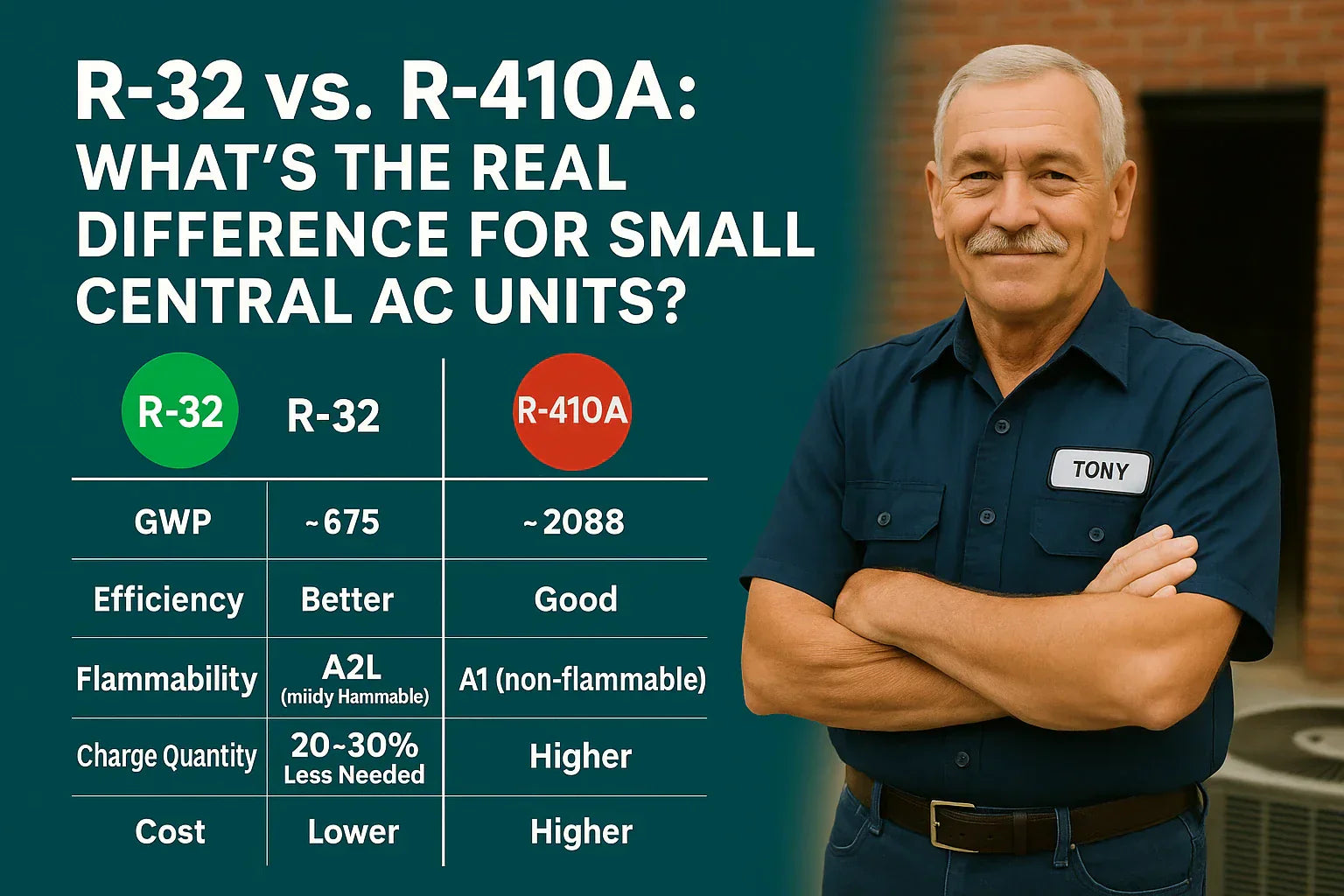When choosing a small central AC system—especially in the 1.5-ton range—many homeowners like Tony are faced with a new question in 2025: Should I go with R-32 or R-410A refrigerant?
With the EPA phasing out high-global warming potential (GWP) refrigerants like R-410A, more residential systems are switching to R-32. But what does that actually mean for your comfort, your energy bills, and your long-term investment?
This comprehensive guide compares R-32 vs. R-410A across performance, efficiency, safety, cost, and environmental impact, giving you everything you need to make an informed decision.
🔧 Why Refrigerant Type Matters in 2025 and Beyond
Refrigerant is the lifeblood of your AC system. It absorbs indoor heat and releases it outdoors. But not all refrigerants are equal in terms of environmental impact and energy efficiency.
Historically, we’ve moved from R-22 (banned due to ozone depletion) to R-410A (a cleaner alternative), and now, as climate regulations tighten, R-32 is the rising standard.
By 2025, the U.S. is actively phasing down high-GWP refrigerants under the AIM Act, and many manufacturers are shifting to R-32.
📘 Learn more: EPA HFC Phasedown Program
🧪 What Is R-410A?
R-410A is a hydrofluorocarbon (HFC) refrigerant composed of a 50/50 blend of difluoromethane (R-32) and pentafluoroethane (R-125). It replaced R-22 in most systems due to its ozone-safe profile.
🔍 R-410A Quick Facts:
-
GWP: ~2088 (very high)
-
Pressure: Operates at higher pressures than R-22
-
Non-flammable (A1)
-
Widely used from 2006 to present
-
Difficult to recycle due to its blend
🌿 What Is R-32?
R-32 (difluoromethane) is a single-component HFC refrigerant now favored for its efficiency and environmental advantages. Though it’s a component of R-410A, using R-32 on its own improves thermodynamic performance.
✅ R-32 Highlights:
-
GWP: ~675 (68% less than R-410A)
-
Better energy efficiency and cooling performance
-
Low charge needed (about 30% less)
-
Mildly flammable (A2L)
-
Fully recyclable and easier to handle
⚙️ R-32 vs. R-410A: Head-to-Head Comparison
| Feature | R-410A | R-32 |
|---|---|---|
| Global Warming Potential (GWP) | ~2088 | ~675 |
| Type | Blend | Single compound |
| Flammability | A1 (non-flammable) | A2L (mildly flammable) |
| Efficiency | Good | Higher |
| Charge Needed | Higher | Lower (30% less) |
| Cost (2025 avg) | Higher | Lower |
| Future Compliance | Phase-down | 2025-ready |
🌡️ Performance in Small Central AC Units (1.5–2 Tons)
R-32 systems shine in compact units, particularly 1.5-ton models. Because R-32 has higher thermal conductivity and better heat transfer properties, it cools air faster with less refrigerant.
🔍 Real-World Performance Gains:
-
Faster cooling cycles
-
Reduced compressor wear
-
Lower energy consumption (up to 10%)
-
Quieter operation in most models
🔗 Carrier Efficiency Comparison
💥 Safety: Is R-32 Too Flammable for Home Use?
R-32 is classified as A2L (mildly flammable). While that sounds alarming, it’s worth noting that:
-
It requires very specific conditions to ignite (like an open flame and sustained leak)
-
It’s used safely in millions of systems worldwide
-
It does not pose a fire risk in sealed, professionally installed systems
Proper ventilation, correct charging procedures, and trained installers reduce risks to near zero.
💵 Cost Comparison: Equipment, Operation & Recharging
In 2025, costs between R-410A and R-32 systems look dramatically different:
📉 Initial Equipment:
-
R-410A: Higher due to declining supply and future phaseout
-
R-32: Lower due to manufacturer shift and mass adoption
💡 Operating Costs:
-
R-32 units use less power and have higher SEER2 ratings
-
Homeowners report $100–$300 in annual savings
🛠️ Recharging/Repairs:
-
R-32: Requires less refrigerant, lowering service costs
-
R-410A: Becoming more expensive and harder to find
🔗 HVAC.com R-32 vs. R-410A Costs
📜 Future-Proofing: EPA Rules & 2025 Refrigerant Bans
Starting January 1, 2025, manufacturers and HVAC contractors are required to follow the EPA’s refrigerant transition policy under the American Innovation and Manufacturing (AIM) Act.
-
R-410A is not banned in 2025, but it is being phased down
-
Systems with R-410A may become harder and more expensive to maintain
-
R-32 is already compliant with upcoming regulations
📘 EPA Refrigerant Transition Info
🧰 Retrofitting: Can You Switch from R-410A to R-32?
Unfortunately, you cannot retrofit an existing R-410A system to use R-32.
Why?
-
R-32 uses different lubricating oil
-
Operates at different pressures
-
Needs specially designed components
-
Poses safety risks in systems not designed for it
If you want R-32, you’ll need to purchase a compatible new system.
🔗 ACHR News: Retrofitting Challenges
👨🔧 Tony’s Experience with R-32 in His 1.5 Ton Unit
"When I upgraded my AC, I had no idea refrigerant type even mattered. My HVAC guy explained how R-410A was on its way out and R-32 would save me money. My 1.5-ton R-32 unit runs smoother, and it’s way quieter than my old one. Best of all—my electric bill dropped about 15%." — Tony, homeowner in Illinois
Tony's setup:
-
1.5-ton R-32 central AC system
-
15.2 SEER2 rating
-
Installed by a licensed A2L-certified HVAC technician
✅ Final Take: Should You Choose R-32 for Your Small AC?
Yes—especially in 2025.
Choose R-32 if:
-
✅ You’re buying a new central AC system
-
✅ You want lower energy bills and better performance
-
✅ You care about environmental impact
-
✅ You want a system that’s compliant with EPA regulations
Avoid R-410A if:
-
❌ You’re worried about future refrigerant shortages
-
❌ You want to future-proof your investment
📝 Final Word
The transition from R-410A to R-32 is not just about compliance—it’s about better performance, lower bills, and choosing technology that lasts. For homeowners like Tony, it’s already made a noticeable difference. If you're upgrading or replacing your AC system in 2025, R-32 is the smart, future-ready choice.
In the next topic we will know more about: How Efficient Is a 1.5 Ton R-32 System? Understanding SEER2 and Utility Savings







